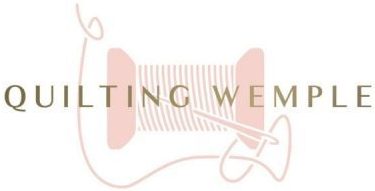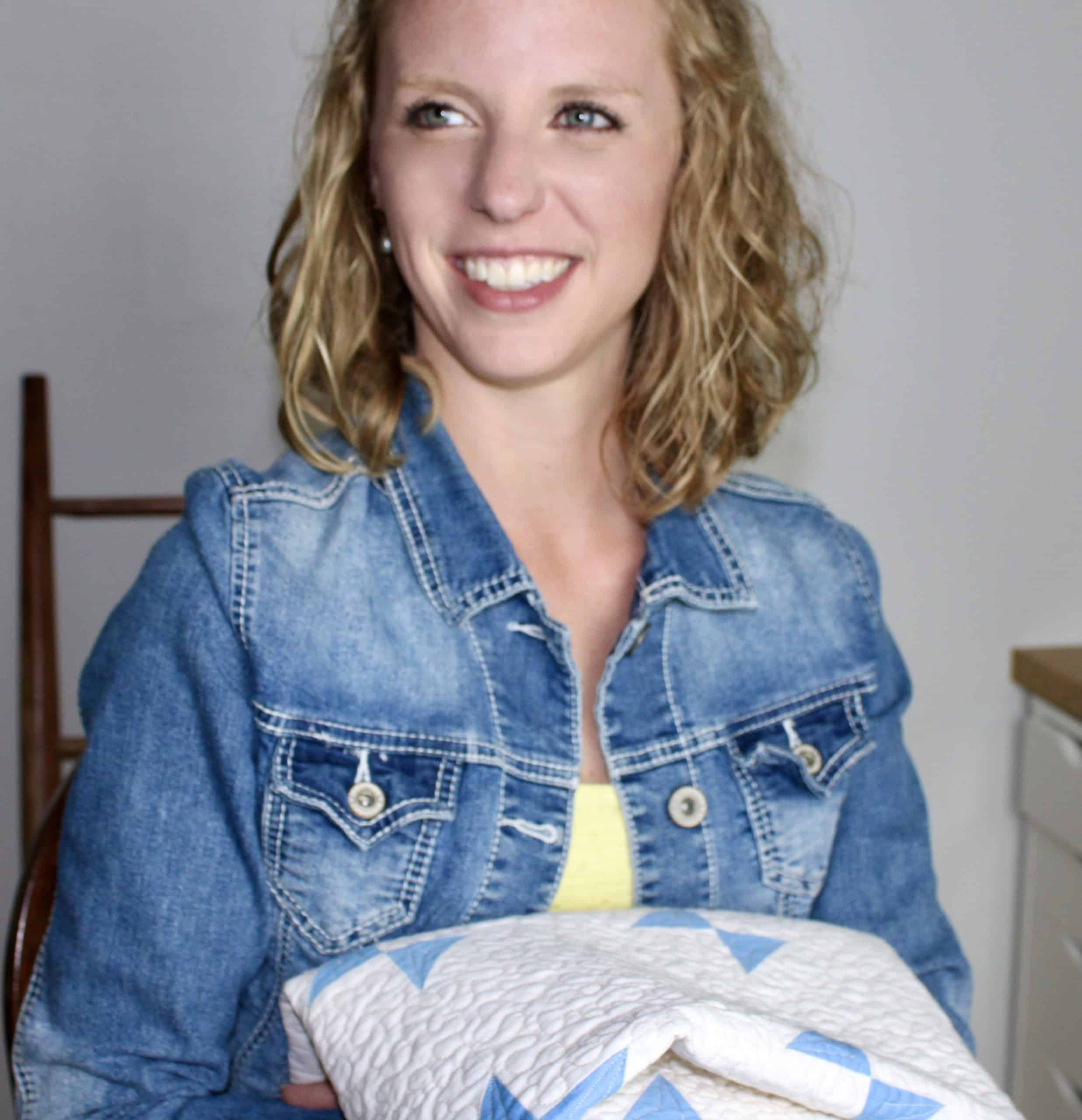
Finally! After piecing every block, and quilting it all up, you are finally at the last stage of making your quilt. This step isn’t too hard, but does take a little know-how. Today I’m talking about how to bind a quilt!
If you are anything like me, you are so excited to get this quilt done that by the time you get to the binding step you are rushing like a mad person.
Because of this, binding a quilt is always the place where I make the most mistakes and have to redo work.
So don’t be like me, if you follow these steps below to learning how to bind a quilt, you’ll be sure to have flawless bindings on your already flawless quilts!
Make or get binding

Step one: Acquire binding
It is possible to buy pre-made binding at the stores however I have personally never opted for this option.
I usually like to pick out and my own binding fabrics so it matches the quilt perfectly so I usually go and make my own.
Related:
How to Make Quilt Binding
Which ever way you decide to go, add up the length of the sides of your quilt first to make sure you know how long of binding you need.
Don’t want to run out before we make it all the way around!
Its always best to go a bit longer just to be sure.
Pick A Place to Start

To start the binding we have to give ourselves a little room.
We will have to attach the end to the beginning later, so take about 8-12 inches and just let it dangle.
There will be a little manipulating at the end to make it the perfect length, so try to find a place to start at least 12 inches away from a corner.
We are going to stop sewing the binding about 12 or so inches BEFORE our starting point.
Make sure you have enough room on the same side of the quilt you are starting on to be able to have that 12 inches without hitting a corner.
Starting and ending on the same side of the quilt will keep the process much less complicated.

ProTip: You are naturally going to have a lot of fabric in the corners with binding. Lay your binding out before sewing along the edges of the quilt to make sure your starting point doesn’t put a binding strip seam right at any corner. This will avoid unnecessary fabric in those spots.
For this step you are going to want to use a walking foot.
While it’s possible to use a regular foot, the walking foot is going to be able to handle all of the layers much better.
Never used a walking foot before? This is the one that I use that fits on many machines.
Start sewing the binding on

Start sewing the binding on to the FRONT of the quilt.
Be sure to put any raw edges against the raw edge of the quilt so it stays in the seam allowance.
Some people like to pin the binding on to the quilt before sewing, others just like to line up the edges as it feeds through the machine.
Both ways are right, so if you trust yourself enough to line it up on the fly go for it, if it’s your first quilt, feel free to pin. This part is totally up to you.
ProTip: This is going to be pretty thick going through the sewing machine so be sure to take it slow to make sure nothing shifts.
Quilt on down the side of the quilt maintaining your 1/4 inch seam allowance as best as you can.
When you get close to a corner take a second to stop because we don’t want to just sew off the edge.
Finishing the First Side

Okay, next step when learning how to bind a quilt, we are going to round the corner.
The goal is to do this without having to cut the binding, so we have to find a way to fold some of the bulk into the corner.
When you get close to the end of the side you are attaching binding on, stop 1/4 inch away from the bottom edge.
Pick up your sewing foot and twist the quilt so you are aimed right at the corner of the quilt, and sew right off the corner.

There should be a sharp corner in the stitches where you twisted.
Go ahead and break your thread.
Start the Next Side

To start the next side, fold the binding against the diagonal seam to make a 90 degree angle.
The binding should be laying the opposite way of the next side you want to quilt.
Fold the binding back on itself so there is a fold right at the edge of the quilt. You should now be laying binding in the correct direction of your next edge.
Start sewing again right at the edge of the quilt and you can go ahead and sew the next side. Nothing fancy, no twisting of the quilt or anything to get restarted.

Just start at the top of the side and reinforce your first few stitches.
Keep going along the edge of the quilt, repeating this process any time you get to a corner.
Getting to the end

When you get close to the end of the last side, be sure to stop at least 12 inches away from the point where you started.
The further away you stop, the easier the ends are to connect.
You can cut off any bulk binding that is left over so all you have is two tails that comfortably overlap.
Marking the last seam
Lay the two tails over each other and make a mark on both tails. This mark is the place where we need our seam to sit on both tails so the binding fits perfectly around the whole quilt.

Where this is exactly on the tails in relation to the stitches isn’t overly important. Don’t stress if you aren’t perfectly in the middle, or closer to one side or the other.
You are however, going to have to sew it, so just try not to be too close to your start and end points for ease of manipulation later.
But when the tails are laid on top of each other with no slack between where the stitching is on either side, one mark should be directly over the second mark.
Sewing the ends together
Next step to bind a quilt? Sewing the binding to connect it to be a single piece.
Unfold your binding on both edges and make a 90 degree angle with the tails, right sides together.
the tail that is at the beginning of where you started attaching the binding should be on the bottom, and the other tail where you stopped sewing should be the top.
Match up your marks in the lower right hand corner of where they overlap.
By matching up your marks, you know exactly where your seam needs to be to make it fit perfectly.

Take a quilting ruler and using the 45 deg angle on it, mark out a 45 degree line.
This should run from the upper left hand corner, to the bottom right hand corner.
It’s always a good idea to pretend to open up the fabric as though it was already sewn to be sure you are connecting the correct ends together and that they aren’t twisted.
Pin it in place and take it over to the sewing machine. Sew directly on the line that you drew.

When you are done, trim the seam to a 1/4 inch seam allowance. Be sure to cut off any dog ears (being careful not to cut the actual quilt).
Disclaimer: This is going to be clumsy. It’s okay. Pro status, try doing this with a kitty who needs to be pet every 3 seconds trying to help…

Press the Seam

Press the seam open and then press the finished binding in half.
Your binding should now be one continuous piece and perfectly fit all around the outside of the quilt.
Finish attaching the binding to the quilt so the gap is closed up.
You’ve officially attached your binding! The hard part is done I promise!
Hand Stitching the back
This is my favorite part of binding a quilt. This is the relaxing part.
Flip your quilt over to the back, and wrap your binding over the edge.
In a perfect world, your binding will be just big enough to reach the line of stitching that attached it to the front.

If not, it’s not the end of the world. In reality it just needs to cover the raw edges.
If it doesn’t reach, it’s likely that your binding was either not cut to the correct width, or your seam allowance is larger than a 1/4″.
Grab a needle and some thread and start hand stitching the binding to the back.
To do this, put a knot in the end of your thread and start a stitch from somewhere in the seam allowance.
Poke your needle up at the line of sewing where you attached the binding to the front.

Take the smallest bite from the binding fabric that would be directly over the spot where your thread comes out of the backing.

Once you have your stitch made, go back right down into the same spot and travel about a 1/4” to the side of the first stitch.
When you start to get the hang of it, you’ll be able to finish one stitch and pick up the next in the same motion. It’ll get quicker. Promise 🙂
ProTip: Don’t travel for your next stitch unless you are inside of the batting. The goal is to minimize seeing this thread as much as possible. You basically want to pop up out of the batting just long enough to grab a piece of the binding, and then go right back in where you originally came out.

Which direction you go across the quilt will depend on your dominant hand and which direction feels more natural.
I am right handed so I typically travel to the left. If you are left-handed, traveling to the right will likely feel more comfortable.
Work your way all the way around the quilt and…..
It’s official! You are finally done!
With the whole quilt!
You. Are. Done.
Congrats!
What’s Next?

Now that you’ve officially learned how to bind a quilt, it’s time to find your next project!
I’m currently building a vault of free patterns that you’re welcome to try for your next project.
So be sure to sign up for my email list below to find out when it goes live!









0 Comments